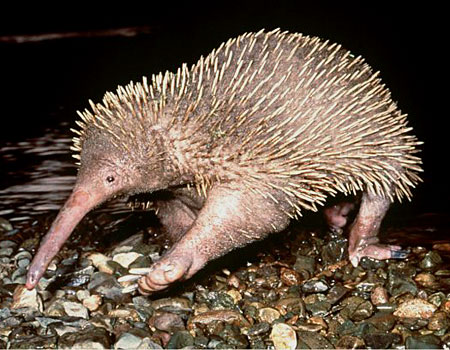tags: Attenborough's long-beaked echidna, Zaglossus attenboroughi, monotreme, endangered animals, New Guinea, Irian Jaya, Cyclops mountain range
Attenborough's long-beaked echidna, Zaglossus attenboroughi,
the only specimen known to exist in museum collections.
Prepared as a shmoo (a flat skin lacking most bones).
Image: Natural Museum of Natural History in the Netherlands (NMNH) [larger]
In May of this year, a team of experts from the Zoological Society of London (ZSL) went on a one-month preliminary research expedition to the Cyclops mountain range in Papua on the island of New Guinea. They were searching for Attenborough's long-beaked echidna, Zaglossus attenboroughi, which was thought have to be extinct for the past 50 years.
Attenborough's long-beaked echidna was discovered by a Dutch botanist in 1961 who returned to the Netherlands with a single, damaged specimen. The animal was collected at 1,600 meters in the cloud forest but has not been recorded since its initial discovery. Throughout the intervening years, scientists did not know if the echidna had not been seen because it succumbed to habitat destruction or because of the notorious difficulties experienced by naturalists when carrying out biological surveys of mountainous regions in New Guinea.
Attenborough's echidna, named for Sir David Attenborough, is one of five species of early egg-laying mammals, known as monotremes, that evolved during the time of the dinosaurs.
"This group includes the duck-billed platypus, which helps demonstrate how different these [animals] are from all other mammals," said Jonathan Ballie, of the Zoological Society of London (ZSL), who went on the expedition.
When the platypus was first discovered by western scientists, it was thought to be an elaborate hoax where parts of different animals were skilfully stitched together.
To search for the rare echidna, the team travelled to remote regions of the jungle-enshrouded mountain range that had been unexplored for more than 45 years. While there, the scientists spoke with the local tribespeople, and seven of them claimed they had seen the echidna as recently as 2005. The locals even have their own name for the animal; the "Payangko". Furthermore, one villager said he had eaten one and described it as "delicious".
Attenborough's long-beaked echidna is the smallest member of the genus, Zaglossus. This species has five claws on its feet (useful for digging), a long nose, and dense, very short fur. Even though their ecology remains mysterious, it is thought that they are similar in many ways to other species in this same genus. Thus, they are thought to breed in July, producing a clutch of 4-6 eggs, which are kept in a pouch. It is thought that this species of echidna inhabits alpine meadows as high as 4,000 meters above sea level, and also humid montane forests. When threatened, it is believed that this solitary species erects its spine-covered coat as protection from predators. They are probably nocturnal, foraging in the forest litter layer for earthworms and other soil-dwelling invertebrates. In fact, the team discovered these "nose pokes" -- the holes in the ground that were made by the echidnas as they stuck their long noses into soil to feed.
As a group, the monotremes are special mammals because they have an interesting evolutionary heritage. They probably split from the lineage leading to other mammals in the Mesozoic. The monotremes are often placed in a separate taxonomic subclass, Prototheria, from other living mammals, which are classed as Theria (the Placentalia and Marsupialia or Metatheria). However, despite this classification scheme, it appears that platypuses might be more closely related to placental mammals while echidnas could be more closely related to marsupials.
While on their expedition, the team ran across many more animals.
"In addition to Attenborough's echidna we found an astonishingly vast array of biodiversity, some of which is highly unlikely to be known to science," said Ballie.
Next year, the team will return to the Cyclops Mountains to carry out further research and to also install camera traps in order to photograph a living Attenborough's long-beaked echidna.
"Our expedition will provide us with a fantastic opportunity to study one of the most extraordinary species on the planet and discover some new ones," said Jonathan Ballie, of the Zoological Society of London (ZSL).
Sources
BBC News (quotes, image)
Metro News (quotes).
Sydney Morning Herald (quotes).
- Log in to post comments



Dear Santa: I never got that pony I wanted when I was 10, so I would like one of these for Winter Solstice.
This is a really cool critter! I will have to remember it if I ever teach historical geology again.
J-dog: where would you put the saddle?
Bob
When I saw the headline and clicked through to here, and got that picture up on my screen first thing, I'm afraid my first thought was "Umm, that one looks dead."
They really are funny-lookin', aren't they. Especially that one in the bottom picture. The feet. The feet just freak me out.
You should see David Attenborough's Lost Worlds Vanished Lives. It's a great story. (btw Dad made them all in the same week)